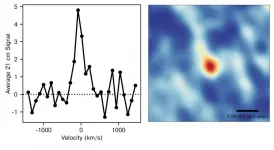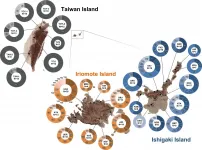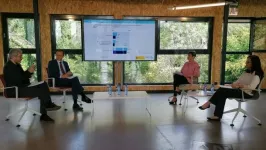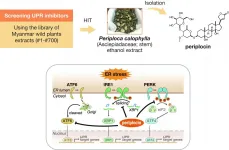(Press-News.org) A research team from the University of Copenhagen and University of Helsinki demonstrates it is possible to predict individual preferences based on how a person's brain responses match up to others. This could potentially be used to provide individually-tailored media content -- and perhaps even to enlighten us about ourselves.
We have become accustomed to online algorithms trying to guess our preferences for everything from movies and music to news and shopping. This is based not only on what we have searched for, looked at, or listened to, but also on how these activities compare to others. Collaborative filtering, as the technique is called, uses hidden patterns in our behavior and the behavior of others to predict which things we may find interesting or appealing.
But what if the algorithms could use responses from our brain rather than just our behavior? It may sound a bit like science fiction, but a project combining computer science and cognitive neuroscience showed that brain-based collaborative filtering is indeed possible. By using an algorithm to match an individual's pattern of brain responses with those of others, researchers from the University of Copenhagen and the University of Helsinki were able to predict a person's attraction to a not-yet-seen face.
Previously the researchers had placed EEG electrodes onto the heads of study participants and showed them images of various faces, and thereby demonstrated that machine learning can use electrical activity from the brain to detect which faces the subjects found most attractive.
"Through comparing the brain activity of others, we've now also found it possible to predict faces each participant would find appealing prior to seeing them. In this way, we can make reliable recommendations for users - just as streaming services suggest new films or series based on the history of the users," explains senior author Dr. Tuukka Ruotsalo of the University of Copenhagen's Department of Computer Science.
Towards mindful computing and greater self-awareness
Industries and service providers are more and more often giving personalized recommendations and we are now starting to expect individually tailored content from them. Consequently, researchers and industries are interested in developing more accurate techniques of satisfying this demand. However, the current collaborative filtering techniques which are based on explicit behaviour in terms of ratings, click behaviour, content sharing etc. are not always reliable methods of revealing our real and underlying preferences.
"Due to social norms or other factors, users may not reveal their actual preferences through their behaviour online. Therefore, explicit behaviour may be biased. The brain signals we investigated were picked up very early after viewing, so they are more related to immediate impressions than carefully considered behaviour," explains co-author Dr. Michiel Spapé.
"The electrical activity in our brains is an alternative and rather untapped source of information. In the longer term, the method can probably be used to provide much more nuanced information about people's preferences than is possible today. This could be to decode the underlying reasons for a person's liking of certain songs - which could be related to the emotions that they evoke," explains Tuukka Ruotsalo.
But researchers don't just see the new method as a useful way for advertisers and streaming services to sell products or retain users. As lead author Keith Davis points out:
"I consider our study as a step towards an era that some refer to as "mindful computing", in which, by using a combination of computers and neuroscience techniques, users will be able to access unique information about themselves. Indeed, Brain-Computer Interfacing as it is known, could become a tool for understanding oneself better."
Nevertheless, there is still a way to go before the technique can be applied beyond the laboratory. The researchers point out that brain-computer interface devices must become cheaper and easier to use before they find themselves in the hands or strapped to the heads of casual users. Their best guess is that this will take at least 10 years.
The researchers also underscore that the technology comes with a significant challenge for protecting brain-based data from misuse and that it is important for the research community to carefully consider data privacy, ownership and the ethical use of raw data collected by EEG.
ABOUT THE EXPERIMENT
In the experiment, participants were shown a large number of images of human faces and asked to look for those that they found attractive. While doing so, their brain signals were recorded. This data was used to train a machine learning model to distinguish between the brain activity when the participant saw a face that they found attractive versus when they saw a face that they did not find attractive.
With a different machine learning model, the brain-based data from a larger number of participants was used to calculate which new facial images each participant would find attractive. Thus, the prediction was based partly on individual participant's own brain signals and partly on how other participants responded to the images.
INFORMATION:
FACTS:
The research article has just been presented at The Web Conference 2021.
The researchers behind the study are Keith M. Davis III and Dr. Michiel Spapé of the University of Helsinki and Dr. Tuukka Ruotsalo.
Ruotsalo's research at the University of Copenhagen's Department of Computer Science focuses on developing cognitive models that combine machine learning and human-computer interaction. Tuukka Ruotsalo develops new types of machine learning methods that can learn user intentions and preferences by measuring human cognition.
Watch the video explaining the research results: https://www.youtube.com/watch?v=EUAy8PyxFgU
A team of astronomers from the National Centre for Radio Astrophysics (NCRA-TIFR) in Pune, and the Raman Research Institute (RRI), in Bangalore, has used the Giant Metrewave Radio Telescope (GMRT) to measure the atomic hydrogen gas content of galaxies 9 billion years ago, in the young universe. This is the earliest epoch in the universe for which there is a measurement of the atomic hydrogen content of galaxies. The new result is a crucial confirmation of the group's earlier result, where they had measured the atomic hydrogen content of galaxies 8 billion years ago, and pushes our understanding of galaxies to even earlier in the universe. ...
Decades of research has revealed the remarkable morphological adaptations of sea snakes to aquatic life, which include paddle-shaped tails, salt-excreting glands, and the ability to breathe through their skin.
In a new study published in Biological Journal of the Linnean Society, researchers at the University of Adelaide detail the enlarged touch receptors that evolved in male turtle-headed sea snakes (Emydocephalus annulatus), to help them locate and court females in aquatic environments.
Lead author, Jenna Crowe-Riddell, PhD graduate at the University of Adelaide's School of Biological Sciences, says on land, snakes use tongue-flicking ...
Older people need digital skills training to learn to use digital technology more independently, but they also seek digital training opportunities because of the social benefits they offer, according to a recent study from the University of Eastern Finland. Published in International Journal of Lifelong Education, the study examined perceived benefits of digital skills training among older adult learners, their teachers and peer tutors. Data for the study were collected in liberal adult education organisations, such as community colleges, as well as in peer tutoring sessions organised by third sector actors.
New skills and friendships
The coronavirus pandemic has, for its part, highlighted inequalities in the availability and ...
The Amami, Okinawa region of Japan may be designated a World Heritage Site in July of 2021 based on the recent recommendation from the IUCN. The Iriomote wild cat is a symbolic species of the region, having evolved independently on the island. The area is home to many other highly endemic and unique evolutionary species. A research group comprised mostly of former students of Professor Koji Tojo's Faculty of Science lab of Shinshu University focused on the study of dragonflies, continuing from their previous study of their comparative embryogenesis. About 5,000 species of insects belonging to 26 families of the order Dragonfly are known ...
A long-standing basic question in biology relates to how life satisfies the fundamental constraints put on it by physics and chemistry. Darwin's warm pond hypothesis for the origin of primordial cells is a familiar one. Advances have been made in mapping out the organic molecules that likely existed on the early Earth, and recently candidate prototypic pathways in early cells have been formulated. But how did these candidates' early biochemistry actually function as a system, on which subsequent cellular life is based?
A team of bioengineers at the Novo Nordisk Foundation Center for Biosustainability, DTU, has now defined ten overarching classes of constraints on early metabolic ...
A minimally-invasive procedure that targets the nerves near the kidney has been found to significantly reduce blood pressure in hypertension patients, according to the results of a global multicentre clinical trial led in the UK by researchers at Queen Mary University of London and Barts Health NHS Trust.
The study, published in The Lancet and presented at the American College of Cardiology meeting, suggests that the procedure could offer hope to patients with high blood pressure who do not respond to recommended treatments (resistant hypertension), and are at greatly increased risk of cardiovascular diseases, including stroke and heart attack.
The international clinical trial tested a one-hour procedure called 'renal denervation', which uses ultrasound energy to ...
The fluorescence dyes were dominant species of the near-infrared (NIR) dyes, but the energy gap of the NIR dyes between S1 state and S0 state is generally small to induce the ultrafast internal conversion dynamics to quench the NIR emission of the fluorescence dyes. Therefore, the quantum yield of the fluorescence NIR dyes is usually low. On the other hand, the organic dyes with room-temperature phosphorescence (RTP) in the NIR region could prevent the ultrafast internal conversion dynamics quenching because of the T1 state and S0 state the organic molecules are spin forbidden.
Recently, scientists in China reported a new assumption to construct ...
The Spanish Foundation for Science and Technology (FECYT) has presented this week at the headquarters of the National Science and Technology Museum in Madrid the main results of the 10th Social Perception of Science Survey carried out in 2020.
The presentation was attended by Pedro Duque, Minister of Science and Innovation, Josep Lobera, Professor of Sociology at the Autonomous University of Madrid (UAM) and scientific co-director of the Survey and the subsequent study, and Rosa Capeáns, Director of the Scientific Culture and Innovation Department of FECYT. Pampa García, Editor-in-Chief of the SINC Agency, moderated a debate in which the results were presented in six blocks: Interest in ...
In the present study, Dr. Hidetoshi Hayashi (Professor, Nagoya City University) and collaborators screened small-molecule compounds that suppress UPR, using Myanmar wild plant extracts library. The screening system to track X-box binding protein 1 (XBP1) splicing activity revealed that the ethanol extract of the Periploca calophylla stem inhibited the inositol-requiring enzyme 1 (IRE1)-XBP1 pathway. They isolated and identified periplocin as a potent inhibitor of the IRE1-XBP1 axis. Periplocin also suppressed other UPR axes, protein kinase R-like endoplasmic reticulum kinase (PERK), and activating transcription ...
Researchers from the Hubrecht Institute in Utrecht (The Netherlands) and the Max Planck Institute for Molecular Biomedicine in Münster (Germany) used computer simulations to reveal in atomic detail how a short piece of DNA opens while it is tightly wrapped around the proteins that package our genome. These simulations provide unprecedented insights into the mechanisms that regulate gene expression. The results were published in PLOS Computational Biology on the 3rd of June, 2021.
Every cell in the body contains two meters of DNA. In order to fit all the DNA ...






